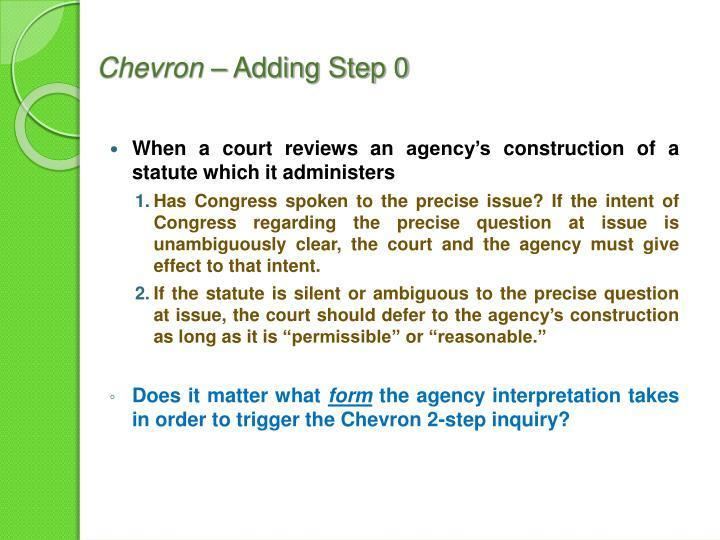Argument Oral argument | End date 1984 | |
 | ||
Docket nos. 82-100582-124782-1591 Citations 467 U.S. 837 (more)104 S. Ct. 2778; 81 L. Ed. 2d 694; 21 ERC (BNA) 1049; 14 Envtl. L. Rep. 20,507; 52 U.S.L.W. 4845; 1984 U.S. LEXIS 118 Prior history Natural Resources Defense Council v. Gorsuch, 685 F.2d 718 (D.C. Cir. 1982), cert. granted sub nom. Chevron U.S.A. Inc. v. Natural Resources Defense Council, Inc., 461 U.S. 956 (1983) Subsequent history Rehearing denied, 468 U.S. 1227 (1984) Similar King v Burwell, Massachusetts v Environm, Michigan v EPA, Citizens to Preserve Overton P, Marbury v Madison | ||
Chevron U.S.A., Inc. v. Natural Resources Defense Council, Inc., 467 U.S. 837 (1984), was a landmark case in which the United States Supreme Court set forth the legal test for determining whether to grant deference to a government agency's interpretation of a statute which it administers. Chevron is the Court's clearest articulation of the doctrine of "administrative deference," to the point that the Court itself has used the phrase "Chevron deference" in more recent cases.
Contents
Background
Under the Supreme Court's ruling in Marbury v. Madison, 5 U.S. (1 Cranch) 137 (1803), United States federal courts have the authority to judicially review the statutes enacted by Congress, and declare a statute invalid if it violates the Constitution. But the Constitution sets no express limits on how much federal authority can be delegated to a government agency. Rather, limits on the authority granted to a federal agency occur within the statutes enacted by Congress.
Facts
Congress amended the Clean Air Act in 1977 to address states that had failed to attain the air quality standards established by the Environmental Protection Agency (EPA) (Defendant). "The amended Clean Air Act required these 'non-attainment' States to establish a permit program regulating 'new or modified major stationary sources' of air pollution." During the Carter administration, the EPA defined a source as any device in a manufacturing plant that produced pollution. In 1981, after Ronald Reagan's election, the EPA, which was headed by Anne M. Gorsuch, adopted a new definition that allowed an existing plant to get permits for new equipment that did not meet standards as long as the total emissions from the plant itself did not increase. The Natural Resources Defense Council (NRDC), an environmental protection group, challenged the EPA regulation in federal court, which ruled in the NRDC's favor. Chevron, an affected party, appealed the lower court's decision.
Issue
The issue facing the Court was what standard of review should be applied by a court to a government agency's own reading of a statute that it is charged with administering.
Holding
The Court, in an opinion by Justice John Paul Stevens, upheld the EPA's interpretation. A two-part analysis was born from the Chevron decision (called the "Chevron two-step test"), where a reviewing court determines:
First, always, is the question whether Congress has directly spoken to the precise question at issue. If the intent of Congress is clear, that is the end of the matter; for the court, as well as the agency, must give effect to the unambiguously expressed intent of Congress. If, however, the court determines Congress has not directly addressed the precise question at issue, the court does not simply impose its own construction on the statute . . . Rather, if the statute is silent or ambiguous with respect to the specific issue, the question for the court is whether the agency's answer is based on a permissible construction of the statute.
Importance
Chevron is probably the most frequently cited case in American administrative law, but some scholars suggest that the decision has had little impact on the Supreme Court's jurisprudence and merely clarified the Court's existing approach.
Chevron, 18 years later, was able to invoke Chevron deference to win another case, Chevron U.S.A., Inc. v. Echazabal, 536 U.S. 73 (2002), before the Supreme Court. In a unanimous decision, the Court applied Chevron deference and upheld as reasonable an Equal Employment Opportunity Commission regulation, which allowed an employer to refuse to hire an applicant when the applicant's disability on the job would pose a "direct threat" to the applicant's own health.
Three 21st-century decisions of the Supreme Court may limit the scope of administrative agency actions that receive Chevron deference to agency decisions that have the "force of law." This new doctrine is sometimes referred to as "Chevron step zero." Thus, for example, a regulation promulgated under the "notice and comment" provisions of § 553 of the Administrative Procedure Act would be likely to receive Chevron deference, but a letter sent by an agency, such as a US Securities and Exchange Commission (SEC) "no-action" letter, would not. However, an agency action that does not receive Chevron deference may still receive some degree of deference under the old standard of Skidmore v. Swift & Co., 323 U.S. 134 (1944). The majority in Christensen v. Harris County (2000) suggested that Chevron deference should apply to formal agency documents which have the force of law while Skidmore should apply to less formal agency documents in an attempt to draw a bright line for the question of "force of law" under Chevron step zero. In King v. Burwell (2015), the Supreme Court has suggested that Chevron deference may be inappropriate in regulatory actions of "profound economic and political significance," hinting at the possibility of substantially limiting, or even eliminating, the doctrine.
Opposition
The United States House of Representatives in the current Congress passed a bill on January 11th, 2017, called the "Regulatory Accountability Act of 2017" which, if made into law, would change the doctrine of Chevron deference. The most recent nominee to the Supreme Court of the United States, Neil Gorsuch, has also written opinions against Chevron deference, with news commentators believing that Gorsuch may rule against Chevron deference on the Supreme Court.
